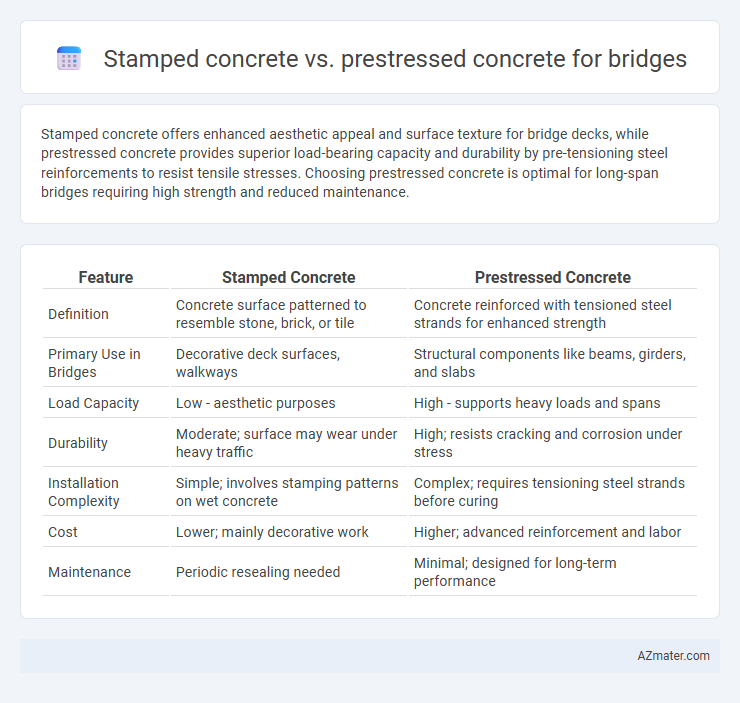Stamped concrete offers enhanced aesthetic appeal and surface texture for bridge decks, while prestressed concrete provides superior load-bearing capacity and durability by pre-tensioning steel reinforcements to resist tensile stresses. Choosing prestressed concrete is optimal for long-span bridges requiring high strength and reduced maintenance.
Table of Comparison
| Feature | Stamped Concrete | Prestressed Concrete |
|---|---|---|
| Definition | Concrete surface patterned to resemble stone, brick, or tile | Concrete reinforced with tensioned steel strands for enhanced strength |
| Primary Use in Bridges | Decorative deck surfaces, walkways | Structural components like beams, girders, and slabs |
| Load Capacity | Low - aesthetic purposes | High - supports heavy loads and spans |
| Durability | Moderate; surface may wear under heavy traffic | High; resists cracking and corrosion under stress |
| Installation Complexity | Simple; involves stamping patterns on wet concrete | Complex; requires tensioning steel strands before curing |
| Cost | Lower; mainly decorative work | Higher; advanced reinforcement and labor |
| Maintenance | Periodic resealing needed | Minimal; designed for long-term performance |
Introduction to Concrete Technologies in Bridge Construction
Stamped concrete enhances bridge aesthetics by replicating natural materials, offering durability and design flexibility. Prestressed concrete significantly improves load-bearing capacity and reduces structural deflection, making it ideal for long-span bridges. Both technologies optimize bridge performance by addressing specific structural and visual requirements in modern bridge construction.
Overview of Stamped Concrete
Stamped concrete, also known as patterned or textured concrete, is a decorative technique used to mimic natural materials like stone, brick, or wood on bridge surfaces. Its advantages include enhanced aesthetic appeal and slip resistance, making it suitable for pedestrian walkways and architectural elements of bridges. While primarily decorative, stamped concrete retains the durability and strength of traditional concrete under standard load conditions.
Overview of Prestressed Concrete
Prestressed concrete for bridges involves the application of pre-tensioning or post-tensioning techniques to improve structural strength and durability, enabling longer spans and reduced material usage compared to traditional concrete. This method significantly enhances load-bearing capacity by inducing compressive stresses that counteract tensile forces experienced in service. Prestressed concrete bridges offer superior resistance to cracking, deflection, and environmental impacts, making them ideal for heavy traffic and demanding infrastructure applications.
Key Differences Between Stamped and Prestressed Concrete
Stamped concrete is primarily decorative, offering textured patterns and colors that mimic natural materials, making it ideal for aesthetic applications on bridge surfaces such as walkways or parapets. Prestressed concrete involves pre-tensioning or post-tensioning steel tendons within the concrete to enhance structural strength, allowing bridges to support heavier loads and span longer distances without excessive material use. Key differences include stamped concrete's focus on surface appearance and durability under pedestrian traffic, while prestressed concrete emphasizes load-bearing capacity and resistance to tensile stresses in critical structural components.
Structural Performance Comparison
Stamped concrete offers enhanced aesthetic appeal and surface texture but typically exhibits lower tensile strength and durability under heavy load conditions compared to prestressed concrete. Prestressed concrete incorporates tensioned steel tendons, significantly improving load-bearing capacity, crack resistance, and structural longevity in bridge applications. Consequently, prestressed concrete outperforms stamped concrete in structural performance metrics critical for bridge safety and durability.
Durability and Longevity
Stamped concrete offers aesthetic appeal but generally falls short in durability and longevity compared to prestressed concrete, especially under heavy bridge loads. Prestressed concrete enhances structural integrity by introducing compressive stresses that counteract tensile forces, significantly improving resistance to cracking, weathering, and fatigue over time. This makes prestressed concrete the preferred choice for bridges requiring long-term durability and low maintenance in demanding environments.
Aesthetic and Design Flexibility
Stamped concrete offers extensive aesthetic versatility with customizable textures and patterns that mimic natural stone or brick, enhancing bridge visual appeal and blending with surroundings. Prestressed concrete provides superior structural efficiency but limited design variation due to its focus on load-bearing performance rather than surface finishes. Designers often choose stamped concrete for visually striking bridge decks and railings, while prestressed concrete ensures durability and strength in the main structural components.
Installation and Construction Processes
Stamped concrete installation for bridges involves pouring traditional concrete, followed by imprinting patterns and textures before curing, which requires careful timing and skilled labor to achieve aesthetic effects without compromising structural integrity. Prestressed concrete construction entails fabricating concrete elements with embedded tensioned steel tendons, either pre-tensioned or post-tensioned, allowing controlled stress distribution and enhanced load-carrying capacity, with specialized equipment necessary for tensioning. The stamped concrete process emphasizes surface detailing and site casting, while prestressed concrete relies on precise tensioning techniques and often prefabricated components to accelerate bridge construction and improve durability.
Cost Analysis: Initial and Long-Term
Stamped concrete involves higher initial costs due to intricate patterns and labor-intensive installation, while prestressed concrete requires substantial upfront investment in tensioning equipment and skilled labor. Long-term, prestressed concrete offers reduced maintenance and longer lifespan, leading to cost savings over time, whereas stamped concrete may incur higher upkeep expenses due to surface wear and potential repairs. Evaluating lifecycle costs, prestressed concrete often proves more economical for bridge construction despite higher initial expenditure.
Choosing the Right Concrete for Bridge Projects
Stamped concrete offers aesthetic versatility with textured, decorative surfaces ideal for pedestrian bridges requiring visual appeal, while prestressed concrete provides superior structural strength and durability essential for heavy-load vehicular bridges. Selection depends on project demands: stamped concrete emphasizes design and surface finish, whereas prestressed concrete enhances load-bearing capacity and resistance to stress. Engineers must consider factors like load requirements, environmental conditions, and maintenance needs to choose the optimal concrete type for bridge longevity and performance.

Infographic: Stamped concrete vs Prestressed concrete for Bridge
 azmater.com
azmater.com